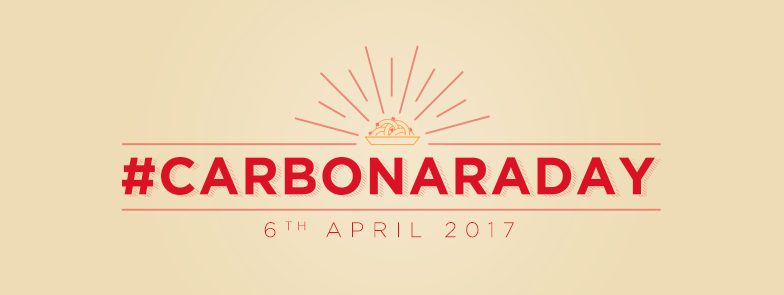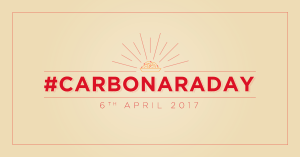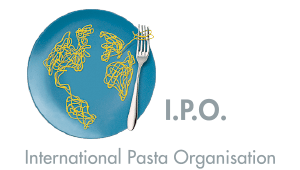6 APRIL 2017: #CARBONARADAY PASTA LOVERS FROM ALL OVER THE WORLD CELEBRATE THE MOST LOVED (AND IMITATED) ITALIAN RECIPE THE DEBATE IS OPEN ON SOCIAL MEDIA: PURISTS OR INNOVATORS?
How to prepare Pasta Carbonara is a discussion that has been going on forever among millions of food lovers all over the world, and the dialogue continues between supporters of the traditional recipe and those who instead love innovation.
To celebrate this dish, famous in every corner of the globe, I.P.O. (International Pasta Organization) and AIDEPI (Italian Association of Confectionery and Pasta Industries) launched:
#CarbonaraDay, on 6 April.
Join us on Twitter 12 noon to 2 pm CEST and 1 to 2 pm EDT
when bloggers, journalists, food influencers and chefs will have their say about this dish,
beloved all over the world, and especially by Millenials in Italy.
ROME, April 5, 2017 – Yes to Guanciale, no to Pancetta and bacon. Yes to Pecorino, no to Parmigiano cheese. Should we add oil? And egg white? Should there be garlic and onion? Pasta Carbonara is the most beloved Italian recipe in the world, but also the most controversial. Purists say there is only one way to make it and only five ingredients: guanciale, pecorino cheese, egg, salt and pepper. The most innovative spirits instead believe that, since pasta is a versatile food, there should be no limits to Carbonara’s culinary interpretation.
The debate is open to all and will be the focus of the #Carbonara Day tomorrow, 6 April. The Twitter event has been created by I.P.O. (International Pasta Organization) and AIDEPI (Italian Association of Confectionery and Pasta Industries) to celebrate this world famous recipe. Just follow #carbonaraday, from 12 noon to 2 pm CEST to take part in the debate between bloggers,food influencers, journalists and chefs who will have their say on this dish and, more in general, on the relation between tradition and innovation in cuisine. The second part of the event will take place between 1 and 2 pm (EDT) to allow American food lovers to contribute to the debate on Carbonara.
CARBONARA IN HISTORY: THE UNCERTAIN ORIGIN OF THIS DISH
In spite of being rooted in the dietary habits of many, this dish has a relatively recent origin. A first hypothesis gives it an American origin. Pasta Carbonara was supposedly part of the ‘K-Ration’ that Ancel Keys, American biologist and physiologist, invented in 1942 to provide the Allied troupes with a suitable diet. American soldiers would mix the ‘K-Ration’, specifically the powdered egg yolk and bacon, with spaghetti to increase the carbohydrate intake. The second hypothesis is that the dish was ‘invented’ by charcoal burners from the Umbrian Apennines (called carbonari in Roman dialect), who prepared this dish using ingredients easy to procure and preserve. In this case, Carbonara would be the evolution of the dish called ‘cheese and egg’ (cacio e ova), originally from the Lazio and Abruzzo regions. Lastly, another hypothesis places the origin of this recipe in Neapolitan cuisine. This theory identifies a possible origin of this dish in some recipes contained in the 1837 treatise Cucina teorico-pratica by Ippolito Cavalcanti.
… AND ITS ETIMOLOGY
Invented by a cook from the city of Carbonia, in Sardinia, who moved to Rome? The typical pasta dressing of the charcoal burners of the forests of Umbria or of the members of the ‘Carboneria’ secret revolutionary society? Or, better yet, the mention of coal hints at the abundant black pepper ground on the top, as if it were dust from the coal mines?
ONE THING IS CERTAIN: ITALIAN MILLENNIALS LOVE IT
There is no other recipe capable of inflaming the passion of Italians like Pasta Carbonara, which used to be a typical recipe of Central Italy and today is a national phenomenon. According to a recent Doxa-Aidepi survey, Carbonara (with Oven Baked Pasta and Spaghetti with Tomato Sauce) is one of the three recipes close to the heart of people ranging from the age of 15 to 35, and it is the absolute favourite of 18 percent of Italians (especially men) and in the North West regions. But Pasta Carbonara is also a global phenomenon, since, according to 2016 Google food trends, it is the most frequently searched recipe in the USA, behind Pasta Bolognese.
FOR THE PURISTS ONLY FIVE INGREDIENTS EXIST: GUANCIALE, PECORINO CHEESE, EGG, SALT AND PEPPER
And, admittedly, the true tradition indicates as ‘historical’ ingredients for the carbonara sauce only: guanciale, pecorino cheese, egg, salt and pepper. And that’s all. Then, anyone can add whatever they like. Revisions are not prohibited. However, those whose intention is to make a true Pasta Carbonara as traditional cookbooks have it, should use only these ingredients: tradition is as good an ingredient as any other. Not even oil is considered a Pasta Carbonara ingredient. In fact, the diced Guanciale that contains up to 50 percent fat melts in the pan, and does the job of the oil.
FIVE MISTAKES TO AVOID AT ALL COSTS
Let’s start from the main ingredient: Guanciale. We always want to make sure to choose it whenever possible, but let’s not despair if every now and then we happen to use flat pancetta instead. Let’s face it: in the Midwest or the Siberian high plains it’s not that easy to get a hold of Guanciale. Then there is the egg: better to use only the yolk, but it wouldn’t be considered a crime to add a little egg white. What needs to be avoided is making an omelette in the frying pan. Let’s move on to more serious mistakes, worthy of an F. The first one is substituting Pecorino with Parmigiano cheese. The Pasta Carbonara tradition originates between the Lazio and Abruzzo regions, the same place of origin of Pecorino cheese. But the most egregious mistake, particularly common outside Italy, is to add cream. This ingredient does nothing but increase the greasiness of the dish, and furthermore it flattens its taste. Finally, garlic and onion are to be avoided, a useless addition as Carbonara is already full-flavoured.
NON-TRADITIONAL INTEPRETATIONS? IN FRANCE, GERMANY AND JAPAN
Outside Italy, many interpretations occur. In France and Germany, for example, freeze-dried Carbonara flavoured preparations are available for sale. In Great Britain, the egg is replaced by béchamel, while in Japan usually cream is added and Pecorino cheese removed.
WHICH PASTA SHAPE IS BEST FOR CARBONARA?
Which pasta shape to use? Will it be short or long? Let’s say right away that both are OK. For many, Carbonara is inseparably tied with the word spaghetti. For others, the ultimate shape for Pasta Carbonara is rigatoni, very Roman indeed (rigatoni pajata, or alla gricia, or in oxtail sauce etc.). At the most, Mezze Maniche can be used.
TO INNOVATORS COOKING IS A CREATIVE ACTIVITY AND NO INNOVATION IS WRONG
Among the food pundits, there are also those who think that pasta interpretations should be unlimited. The American journalist Adam Gopnik of The New Yorker last year drew attention to the fact that many recipes typical of the peasant tradition are born of pure improvisation, from what is available in the fridge, without following a precise recipe. His point is that there should be no constrictions imposed by tradition, but to cook in an environment where ‘lack’ of ingredients purposely stimulates creativity. A Pasta Revolution! The next date for all pasta lovers will be the World Pasta Day in São Paulo, Brazil, on 25 October!




